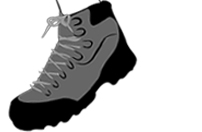Walking The Distance
In his memoir of walking the Camino De Santiago across northern Spain, Wayne Chimenti focuses on the importance of the slow, dedicated pace of pilgrimage, as a contrast to the quick, motorized transportation people have become accustomed to.
 Writing of his ascent up a mountain to the Cruz de Ferro, Chimenti notes with disappointment, “To our chagrin, it turns out that a road drove right to the cross from the other side of the mountain. Tourists were freely wandering around our hard fought ground… It was like climbing Mt. Everest and finding out a tour bus had driven up the other side.”
Writing of his ascent up a mountain to the Cruz de Ferro, Chimenti notes with disappointment, “To our chagrin, it turns out that a road drove right to the cross from the other side of the mountain. Tourists were freely wandering around our hard fought ground… It was like climbing Mt. Everest and finding out a tour bus had driven up the other side.”
It’s tradition on the Camino for pilgrims to carry a stone that they will lay to rest at the base of the Cruz de Ferro after climbing the mountain. The act is symbolic of the shedding of burdens through sacrifice, the point not just being to move a stone to the Cruz de Ferro, but to carry it there, and to feel its weight along the way.
If Chimenti felt cheated when he discovered that people could merely drive up the mountain that he had worked to climb, it wasn’t because he was seeking an easier journey. It was because he understood that the difficulty of the journey was necessary to bring the intended meaning to the journey to Cruz de Ferro. The point of reaching the top of the mountain was the climb, not the view from the summit. The slow pace of the climb affords pilgrims the opportunity to struggle with themselves, and to reflect on their motivation to undergo the ordeal. For those who take the drive instead, the mountain is little more than a bump in the road.
Chimenti saw that his walk was a ritual of passage. Chimenti and his fellow walkers weren’t only trying to reach a destination. They were working to become something more than they had been.
As I read Chimenti’s account of his pilgrimage along the Camino, my thought moves to the process of market research. It’s natural that in the business world, some emphasis is given to efficiency, and so, the most frequent form of market research is quantitative, and the most qualitative research is done in the form of surveys and focus groups. They’re quick and to the point, and they process a large number of respondents through the research process with relatively little fuss, giving market research clients their desired N.
Of course, getting the N of a particular sort of respondents isn’t really the point of research, is it?
When the purpose of a market research project is to gain insight into the behaviors and motivations of consumers, quick trips into the field to get a rough view of the conceptual landscape can be a useful start. To really get a feel for what that landscape feels like, though, there is no replacement for a long, slow hike over the entire terrain.
That’s what in-depth qualitative research is for. It’s like a pilgrimage, for respondents, for researchers and for clients as well. It takes time, and it tends to lead people into some difficult territories, but the dedication and patience it requires yield high rewards.
There are discoveries that cannot be found sitting down, gazing through the window of a bus.
